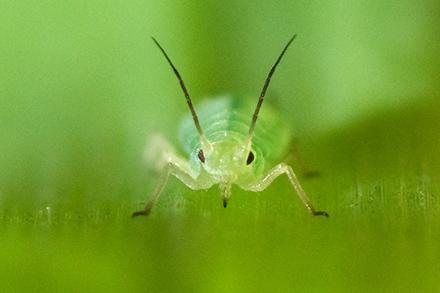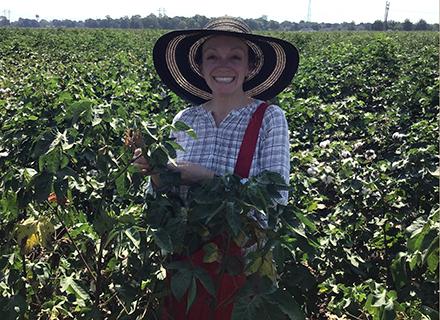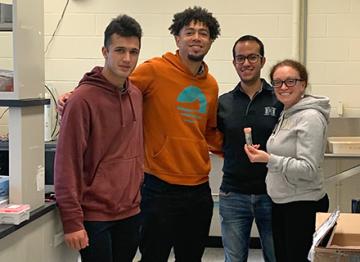Fighting Aphid-Borne Disease in Crops

Close-up of greenbug aphid, Schizaphis graminum, showing the piercing-sucking mouthparts it uses to feed and inject virus into plants. (Photo by Kent Loeffler)
The infamous spike protein doesn’t just help spread viruses – it can also be weaponized to stop them.
The tiny insects known as aphids have long been an enemy of people who grow plants, from home gardeners to farmers. Their voracious appetite for sap can wreak havoc, but for many growers, another threat they pose is even worse: disease. Aphids are vectors – that is, means of transmission – for many of the most lethal viruses affecting cash crops like soy and cotton. However, one researcher at the USDA’s Agricultural Research Service may have found a potent weapon against the aphids’ harmful effects, within the very viruses they spread.
Since the arrival of COVID, the so-called “spike protein” has been getting a lot of attention. The irregular shape that protrudes from the surface of a virus plays a starring role in transmitting coronaviruses; as it turns out, it is critical to the transmission of other viruses as well – including several that afflict crops. Poleroviruses, in particular, infect many economically important crops, including those used in biofuel; they are also an emerging threat to cotton.
The secret to combatting those viruses, and others with similar traits, appears to be turning their own structure against them. Michelle Heck, a research molecular biologist at the ARS Emerging Pests and Pathogens Research unit in the Robert W. Holley Center for Agriculture & Health, explained: “Using X-ray crystallography, we know what that spike protein looks like on that virus,” she said. “That was a major breakthrough, because these viruses have been studied for a very long time, since the 1960s, and no one has been able to look at the structure.

Molecular biologist Michelle Heck scouts for aphids in a cotton field. (Photo by Jennifer Wilson, Cornell University)
“Once you see proteins of a virus, or any protein, you know the sequence in a linear way, but you don’t really know how something works until you put it all together. Think about the engine of a car. If you put all the pieces of an engine on the floor, you can kind of guess what each piece does, but how it all works together – you can’t figure that out. But if you open the hood of a car and see the engine intact, you can see: wow, this is how the thing works. When you solve the structure of a protein, it allows you to see how the protein machine works.”
With that knowledge in hand, Heck and her former graduate student, Jennifer Wilson, now a research molecular biologist at the ARS Corn, Soybean and Wheat Quality Research unit in Wooster, OH, were able to devise an ingenious approach to preventing aphids from spreading the lethal plant viruses: they manufactured free spike proteins like the ones that normally appear on the surface of viruses, only this time, there was no virus – only the spike protein itself. They then fed the loose proteins to aphids. Essentially, Heck explained, the free-floating proteins blocked the viruses from infecting aphids by binding with receptors in the aphids’ cells. Normally, when a virus infects an aphid, the spike proteins on the surface of the virus latch into place by binding to those receptors; with the receptors already occupied by the manufactured spike proteins, there is nothing for the virus spike proteins to latch on to.
The results were so significant that Heck, Wilson and their team published a paper about them in Nature Communications, a leading scientific journal. They are, according to Heck, “revolutionary, because there is no way to block the transmission of these viruses by aphids yet.”
Not only could this solution dramatically reduce disease transmission, but it could do so relatively safely compared to treatments like pesticides, which often have toxic side effects.

Michelle Heck with trainees in her virology program (Photo courtesy of Michelle Heck)
“The spike protein isn’t toxic,” said Heck. “It’s in the food supply because these viruses are ubiquitous [found everywhere]. There are so many viruses related to this one, our analysis showed that this structure is probably the blueprint for this particular protein in all of these related viruses” – meaning that it may be useful for combatting other crop-killing diseases as well.
And there’s more: in addition to preventing the aphids from spreading the viruses, Heck found that the loose spike proteins were highly lethal to the insects, opening up even more possibilities: “This could be used as a novel insecticide that also blocks transmission,” said Heck. “You get a 1-2 punch: in the aphids that you don’t kill, transmission would be blocked.” The most promising route to deliver the spike proteins to aphids would likely be through crop plants themselves – by making, Heck said, “a transgenic plant expressing this spike protein.” She noted that transgenic crops are currently accepted and used in some agricultural sectors. Two new graduate students in Heck’s laboratory, Stephanie Preising and Michael West-Ortiz, are leading research to test ways in which transgenic plants can be used alongside non-transgenic plants to protect the non-transgenic plants from getting infected.
Like all novel solutions, the free spike proteins will be tested to ensure they would be safe before being used in any live applications. For now, though, Heck believes she has the beginnings of a powerful new tool against one of agriculture’s tiny, but mighty, foes. – Kathryn Markham, ARS Office of Communications
You May Also Like:

